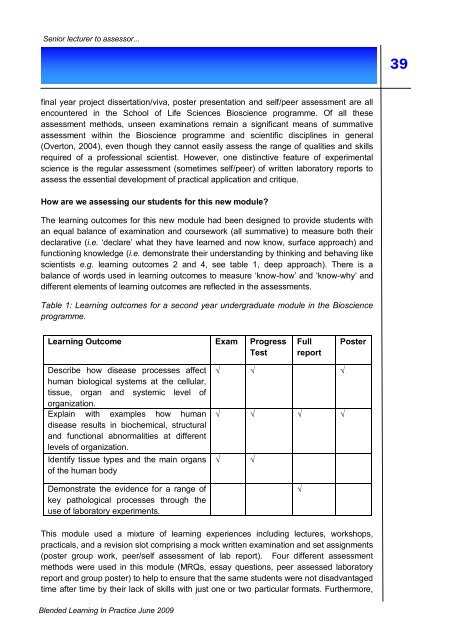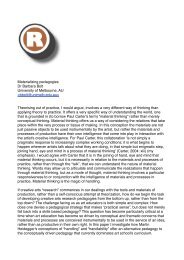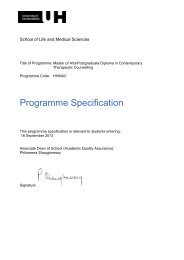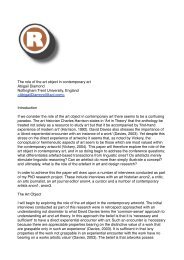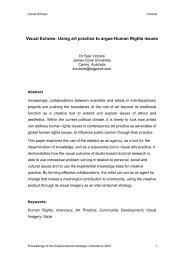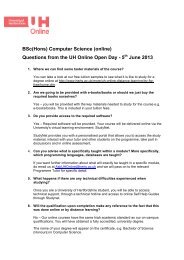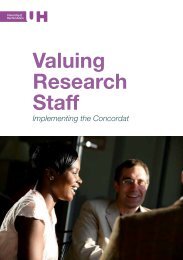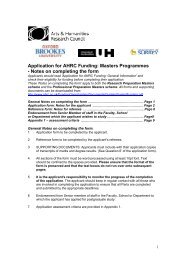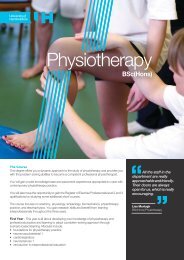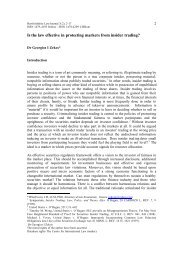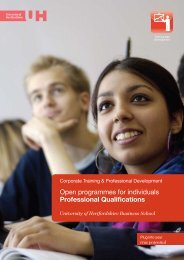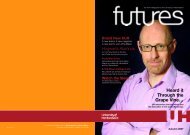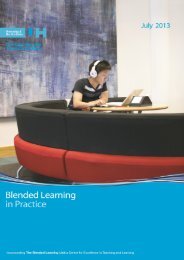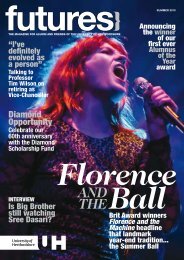June 2009 - University of Hertfordshire
June 2009 - University of Hertfordshire
June 2009 - University of Hertfordshire
You also want an ePaper? Increase the reach of your titles
YUMPU automatically turns print PDFs into web optimized ePapers that Google loves.
Senior lecturer to assessor...<br />
39<br />
final year project dissertation/viva, poster presentation and self/peer assessment are all<br />
encountered in the School <strong>of</strong> Life Sciences Bioscience programme. Of all these<br />
assessment methods, unseen examinations remain a significant means <strong>of</strong> summative<br />
assessment within the Bioscience programme and scientific disciplines in general<br />
(Overton, 2004), even though they cannot easily assess the range <strong>of</strong> qualities and skills<br />
required <strong>of</strong> a pr<strong>of</strong>essional scientist. However, one distinctive feature <strong>of</strong> experimental<br />
science is the regular assessment (sometimes self/peer) <strong>of</strong> written laboratory reports to<br />
assess the essential development <strong>of</strong> practical application and critique.<br />
How are we assessing our students for this new module?<br />
The learning outcomes for this new module had been designed to provide students with<br />
an equal balance <strong>of</strong> examination and coursework (all summative) to measure both their<br />
declarative (i.e. „declare‟ what they have learned and now know, surface approach) and<br />
functioning knowledge (i.e. demonstrate their understanding by thinking and behaving like<br />
scientists e.g. learning outcomes 2 and 4, see table 1, deep approach). There is a<br />
balance <strong>of</strong> words used in learning outcomes to measure „know-how‟ and „know-why‟ and<br />
different elements <strong>of</strong> learning outcomes are reflected in the assessments.<br />
Table 1: Learning outcomes for a second year undergraduate module in the Bioscience<br />
programme.<br />
Learning Outcome Exam Progress<br />
Test<br />
Full<br />
report<br />
Poster<br />
Describe how disease processes affect<br />
human biological systems at the cellular,<br />
tissue, organ and systemic level <strong>of</strong><br />
organization.<br />
Explain with examples how human<br />
disease results in biochemical, structural<br />
and functional abnormalities at different<br />
levels <strong>of</strong> organization.<br />
Identify tissue types and the main organs<br />
<strong>of</strong> the human body<br />
Demonstrate the evidence for a range <strong>of</strong><br />
key pathological processes through the<br />
use <strong>of</strong> laboratory experiments.<br />
√ √ √<br />
√ √ √ √<br />
√ √<br />
√<br />
This module used a mixture <strong>of</strong> learning experiences including lectures, workshops,<br />
practicals, and a revision slot comprising a mock written examination and set assignments<br />
(poster group work, peer/self assessment <strong>of</strong> lab report). Four different assessment<br />
methods were used in this module (MRQs, essay questions, peer assessed laboratory<br />
report and group poster) to help to ensure that the same students were not disadvantaged<br />
time after time by their lack <strong>of</strong> skills with just one or two particular formats. Furthermore,<br />
Blended Learning In Practice <strong>June</strong> <strong>2009</strong>


